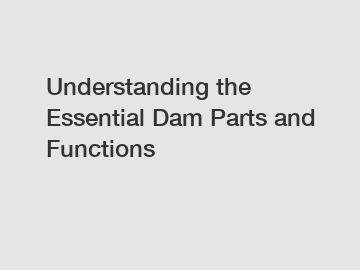Understanding the Essential Dam Parts and Functions
Google Hot Topics: Understanding the Essential Dam Parts and Functions?
Dams play a crucial role in our society, providing a range of benefits including flood control, irrigation, and hydropower generation. However, understanding the essential dam parts and functions is key to ensuring their safe and effective operation. In this article, we delve into the various components of a dam and explore their vital functions.
1. Reservoir:

The reservoir is the heart of a dam and serves as a large water storage area. It is created by impounding water flowing through a river or stream. This storage provides a regulated supply of water for various purposes like drinking, crop irrigation, and industrial use. Additionally, the reservoir helps mitigate flood risks by holding excess water during heavy rainfall and releasing it gradually.
2. Spillways:
Spillways are designed to control and direct water flow downstream to prevent damage to the dam structure during excessive inflow. These critical components act as safety valves, allowing excess water to bypass the dam safely. Understanding the functioning of spillways is vital in ensuring the dam's structural integrity and avoiding disastrous overtopping events.
3. Dam Body:
The dam body is the physical structure that holds back the water in the reservoir. It can be made of various materials such as concrete, earth, or rock fill. Its stability is crucial to prevent catastrophic failures. Regular inspections and maintenance are essential to identify any potential weaknesses or erosion that might compromise its integrity.
4. Intake Structure:
The intake structure is responsible for diverting water from the reservoir to a canal or penstock for various purposes such as irrigation or power generation. It typically consists of gates, screens, and trash racks to control the flow and remove debris and sediments. Maintaining the intake structure is crucial to ensure the uninterrupted supply of water to downstream users.
5. Powerhouse:
In dams used for hydropower generation, the powerhouse is where the magic happens. This structure houses the turbines, generators, and associated equipment to convert the hydraulic energy of flowing water into electricity. Understanding the powerhouse and its components, such as penstocks and turbines, helps optimize the power generation process and ensure efficient utilization of water resources.
6. Outlet Works:
Outlet works are designed to release water from the reservoir for downstream flow regulation, environmental preservation, or maintenance purposes. These outlets, comprising gates or valves, allow controlled discharge while maintaining the desired reservoir levels. Proper management of outlet works is vital to maintain a balance between water supply and downstream requirements.
7. Emergency Spillways:
Emergency spillways serve as an additional line of defense in case the primary spillways are overwhelmed or damaged. These backup channels provide an alternative path for releasing excessive water during extreme events, reducing the risk of dam failure. Understanding the location and function of emergency spillways is critical for disaster preparedness and ensuring the safety of downstream communities.
In conclusion, understanding the essential dam parts and functions is crucial for the effective and safe operation of these critical infrastructure components. From the reservoir and spillways to the intake structure and powerhouse, each component plays a vital role in providing multiple benefits to society. Regular inspections, maintenance, and disaster preparedness are key elements in ensuring the longevity and efficiency of dams. By comprehending these crucial elements, we can better appreciate the engineering marvels that dams represent and utilize their potential to the fullest.
If you want to learn more, please visit our website landscape Inflatable Rubber Dam, remote control hydraulic dam, Rubber Dam Factory.


